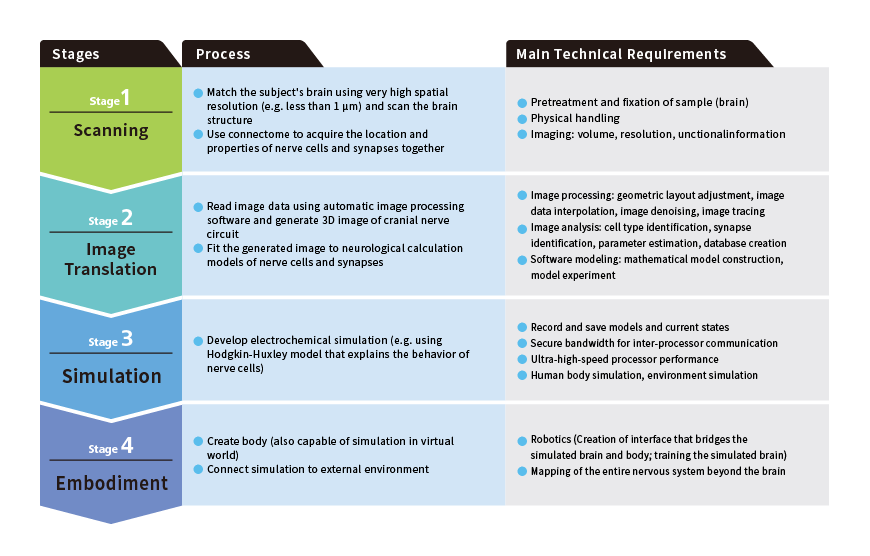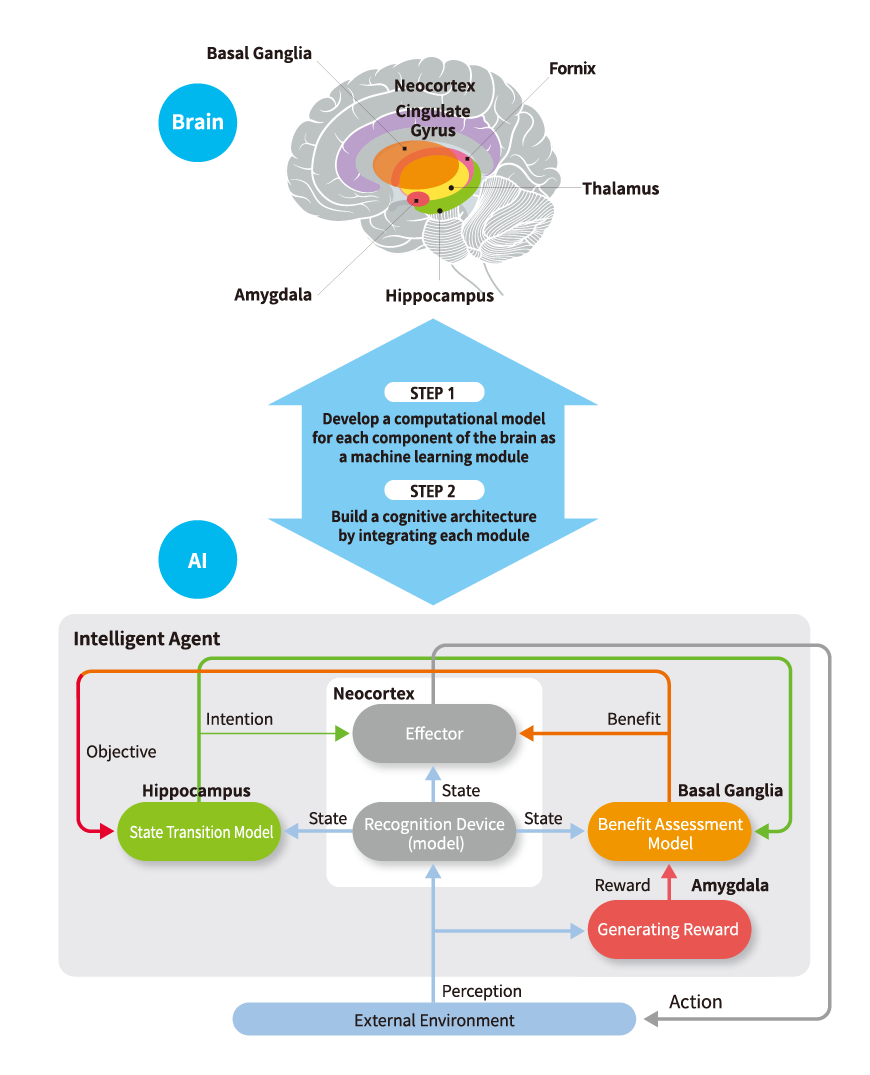
A world where AI provides humans with close support through super-human intellect
Development of Brain-Inspired AGI
The Benefits of AGI Development Based on the Brain
Since the beginning of research on artificial intelligence (AI), it has been held that referring to mechanisms of the human brain will offer insights into the development of AI featuring versatile intelligence, or in current terms artificial general intelligence (AGI). Among the benefits of AGI based on the brain, the scientific community has high expectations for: the potential to leverage knowledge from existing fields of research including those on the human brain and nerves; the ease to reach broad consensus on a foundation for the integration of technologies; and the ease to develop a form of AGI that is highly compatible with humans..
Research in the areas of neuroscience and machine learning has progress in recent years, and the knowledge gained from the related research projects can now be utilized for the development of AGI. Two examples of the application of research results to the development of AGI are described below. The first example is on whole brain emulation (WBE), which uses hardware-based concepts to emulate the whole brain from the molecular and atomic levels. The second example is whole brain architecture (WBA), which uses software-based concepts to interpret and integrate each component of the brain as a computational model. Table 1 provides an outline of the two approaches.
Representative Approaches to AGI Based on the Brain
| Approach |
Whole Brain Emulation (WBE) |
Whole Brain Architecture (WBA) |
|---|---|---|
| Overview |
|
|
| Implementation |
|
|
| Advantages |
|
|
| Challenges |
|
|
| Current Situation & Timeframe |
|
|
Source: Created by Mitsubishi Research Institute based on Nick Bostrom Superintelligence: Path, Dangers, Strategies (Nikkei Business Publications, 2017), Whole Brain Architecture Initiative (WBAI) workshop materials
WBE: Emulation of the Whole Brain from the Molecular and Atomic Levels
WBE can be broken down into four stages: (1) scanning, (2) image translation, (3) simulation, and (4) embodiment (Figure 1).
Four Stages of Whole Brain Emulation

Source: Mitsubishi Research Institute. ed. Phronesis Vol. 22 13th Human Being (Diamond, 2020)
(Created by Mitsubishi Research Institute based on Nick Bostrom Superintelligence: Path, Dangers, Strategies (Nikkei Business Publications, 2017), Murray Shanahan: The Technological Singularity(NTT Publications, 2016))
WBE scans at a very high spatial resolution (i.e. less than 1 μm), as shown in Step 1. Components of the brain subject to emulation are gradually expanded until the whole brain is covered—a very time consuming process. Presently, the only organism for which all nerve cells and synapses have been elucidated is the nematode. The number of nerve cells and synapses in nematodes is incomparably smaller than humans and the reason for their early elucidation*1. Technical challenges are also abound, with the lack of a microscope capable of scanning brain image data in detail*2 as one primary example.
According to a roadmap proposed by Nick Bostrom, a Professor at the University of Oxford, technical requirements are expected to be met in the middle of the 21st century*3. At present, research and development of WBE is in many cases being carried out incidentally as a part of projects mainly focusing on brain disease research.
WBA: Interpretation and Integration of Brain Components as Computational Models
The WBA approach can be broken down into two steps: (1) development of a computational model for each component of the brain as a machine learning module, and (2) building of a cognitive architecture by integrating each module (Figure 2). For example, the cerebellum is thought to correspond to the machine learning modules of supervised learning, basal ganglia to modules of reinforcement learning, and the cerebral neocortex to modules of unsupervised learning. WBA-specific challenges also exist such as the need to consider how to integrate modules.
Steps for the Realization of Whole Brain Architecture

Source: Mitsubishi Research Institute. ed. Phronesis Vol. 22 13th Human Being (Diamond, 2020)
(Created by Mitsubishi Research Institute based on WBAI:The WBA Approach, https://wba-initiative.org/en/wba/)
The WBA development policy differs depending on organization. Some limit the target of modeling to the cerebral neocortex, which is characteristic of higher organisms such as humans, while others, like the Japanese NPO Whole Brain Architecture Initiative (WBAI)*4, include the peripheral area as well.
At present, many projects are focused on creating elemental technologies and developmental methodologies during a timeframe spanning from the 2020s to the 2030s.*5. Some corporations are also leveraging machine learning technologies in their business activities.
Influx in People and Funding from Related Fields Will Accelerate AGI Development
As both the WBE and WBA approaches face numerous technical challenges, it will likely take a long time before AGI can be realized. However, as was the case with deep learning in the machine learning field, there will be technological breakthroughs that cannot yet be foreseen and such innovations may accelerate the development of AGI.
Both the technological progress of machine learning and advancements in various fields of research related to humans are driving the research and development of both WBE and WBA. For example, recent progress in the field of neuroscience*6 has contributed to gains for both WBE and WBA. Gradual progress has also been seen in research on how the various areas of the brain function and are linked together, and such insights provide useful knowledge for constructing cognitive architecture.
Together with the universe, the human brain is said to be the last frontier of humankind, serving as a very interesting subject for both intellectual curiosity and research.
In order to realize AGI, the capability of common sense, acquired by humans naturally, must be added to current forms of AI. Questions in the face of such a task include: will AI be able to naturally grow this human common sense if fed with sufficient knowledge and concepts about the world? Is a technical breakthrough indispensable to achieve this feat? To answer such questions, knowledge must be amassed from various fields and analyzed using a comprehensive approach. Understanding of intelligence itself will advance through AGI research and development, and the process will likely include a wealth of intriguing discussion on how to, or if we even should, develop mental capacities such as consciousness and emotion for AI.
The challenge for the realization of both the WBE and WBA approaches lies in the slow pace of development at present. However, the AGI field, including the WBE and WBA approaches, will see an increase in research and development due to an influx of people and funding because of the ease in contributing to AGI with knowledge from related fields and fascination in the brain as a subject of study.
- *1: The nematode consists of 302 nerve cells and 6,393 synapses whereas the human brain is said to have about 100 billion nerve cells and more than 100 trillion synapses.
- *2: The resolution level must be improved, and sufficient throughput is also required so that the import of image data does not take too long. For example, currently available scanning tunneling microscopes with atomic level resolution require too much to acquire image data in the WBE approach.
-
*3: Whole Brain Emulation A Roadmap
https://www.fhi.ox.ac.uk/brain-emulation-roadmap-report.pdf
(Accessed: May 11, 2020) -
*4: Whole Brain Architecture Initiative
https://wba-initiative.org/
(Accessed: May 11, 2020) -
*5: “A Survey of Artificial General Intelligence Projects for Ethics, Risk, and Policy,” Global Catastrophic Risk Institute Working Paper 17-1, Seth Baum, Global Catastrophic Risk Institute, November 12, 2017
https://papers.ssrn.com/sol3/papers.cfm?abstract_id=3070741
(Accessed: May 11, 2020) - *6: Knowledge of connectome (neural circuit map showing neural connections in the brain), use of functional magnetic resonance imaging (fMRI), etc.
